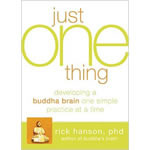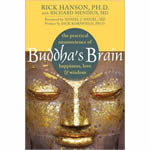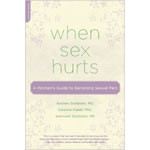
 Hanson, R. (2011). Just One Thing: Developing a Buddha Brain One Simple Practice at a Time.
Hanson, R. (2011). Just One Thing: Developing a Buddha Brain One Simple Practice at a Time.
Reviewed by: Michael Fiorini, New York University
Just One Thing: Developing a Buddha Brain One Simple Practice at a Time is a step by step guide aimed towards improving psychological well being in all aspects of personal, social, and emotional life. The book incorporates a mildly Buddhist-influenced perspective as it guides readers through a series of techniques aimed at improving the quality of human experience. Mindfulness is central to the narrative throughout, and steps are broken down so that the book, which is primarily concerned with self-help, can be as useful and accessible as possible. No single part or step is necessary here, either. The book stresses that one need not bog themselves down in the semantics and particularities of the provided guidelines and instructions if they feel there is a better means of achieving the book’s goals. There is also an intermittent psychological and neuroscientific presence and occasional explanation for the mindfulness process taught. Engaging the self to positively impact neuroplasticity through repetition and practice is the end goal, and through following the book, a diverse audience might benefit from its techniques and conceptual approach.
The driving point in Just One Thing is that small changes in daily routine can have a large positive impact on stress, health, and overall emotional life. In its own words, the book aims to help you “be good to yourself, enjoy life as it is, build on your strengths, be more effective at home and work, and make peace with your emotions.” The way this is achieved is through the practice of the book’s series of fifty-two mindfulness exercises. Separated into five parts, the sections cover being good to yourself, enjoying life, building upon strengths, engaging the world, and being at peace, respectively. The design of the book is such that the basic exercises build upon one another so that when read in order readers become more engaged in their emotional awareness. The model followed here is aimed towards expanding conscious awareness and bears some degree of similarity to cognitive behavioral therapy. Since the narrative and presentation styles are designed like a self-help book with less overt psychological or scientific explanations, the book is accessible to a diverse crop of readership. Professionals will find the book especially useful for its different methods for increasing mindfulness that might help them direct their own instructions during therapy with clients. The lessons included are crucial to improving the human experience on a basic level while also avoiding being too dry or heavy handed in new-age thinking. This might help some readers to reinvigorate their therapeutic practice and reconsolidate goals. That there is a definite neuroscientific influence present in the book furthers its broad clinical efficacy.
A self-help book that combines the underlying principles of CBT with a new-age influenced outlook on mindfulness, Just One Thing is promising in its potential application. While at times quite simple, it is the book’s boiled down elements and easy to read style that make it most effective. Not meant to be followed strictly and not expecting the kind of dedicated consistency other contemporaries demand, it is made for the average reader to pick up and use as needed. Not dedicating more than a few pages per lesson makes this style maintain its point. Those who already have a background in mindfulness training will find this book helpful in honing goals and outcome expectancies, and those who do not will benefit from the gradual building process that it presents. Readers open to doing so will find that, even after a short read, they will be shown useful and practical techniques for the present moment.
Rick Hanson, PhD, is a neuropsychologist and Affiliate of the of the Greater Good Science Center at the University of California. He has been invited to speak at numerous universities, including Oxford, Harvard, and Stanford. He is also the author of Buddha’s Brain.
Hanson, R. (2011). Just One Thing: Developing a Buddha Brain One Simple Practice at a Time.
Oakland, CA: New Harbinger.
ISBN: 978-1-60882-031-3.
Paperback. 224 pages. Includes references.




